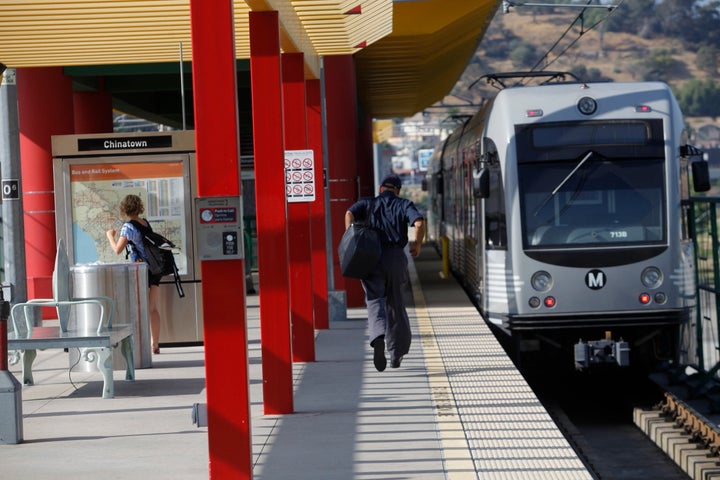
People stranded without a car may have better luck finding a bus in Los Angeles than in the greater New York City area, a new report from the Brookings Institution has found.
Of all major metropolitan areas in the country, Los Angeles does the best job of giving people without cars access to public transportation, according to the study. 99.1 percent of no-car households in the Los Angeles-Long Beach-Santa Ana area have access to public transit, a figure bested only by much smaller Honolulu, where 99.3 percent of carless residents have transit access.
That means that in those California cities, nearly 355,457 carless households most of them low-income, rely on transit to get around. In the New York region, including suburban parts of New Jersey and Pennsylvania, more than 2 million households without cars use the subway or a bus. Yet given the higher population, the overall rate of access there is slightly lower, at 98.7 percent.
Adie Tomer, the author of the report, said he wasn't surprised by the findings, despite "that classic archetype L.A. residents have to deal with all the time -- that L.A. is the capital of car culture."
"The reality is, it's also really good transit culture too when it comes to the ability to get on a bus," Tomer said.
Reached by phone, a Los Angeles County Metropolitan Transportation Authority official seemed unaware of the study's findings but pleased by L.A.'s top ranking.
"That's good news to hear," Metro spokesperson Marc Littman said. "But the better news is that there's going to be even better access in the future."
Where Los Angeles lags, the report and one that came before it suggested, is in providing the hundreds of thousands of carless Angelenos with a quick commute.
In that respect, L.A. has a lot of work to do: only 36 percent of zero-vehicle households can get to their place of employment in 90 minutes or less (that figure includes areas not served by Metro). The region's dispersed job centers -- Downtown, Culver City, Beverly Hills, and elsewhere -- make it difficult for transit to connect commuters to a single central business district.
Metro argues that its rapidly expanding rail network, catalyzed by funds from the Measure R sales tax, will enable people to get to work more quickly. Mayor Antonio Villaraigosa has made changing the city's car-centric reputation, through efforts like garnering voters' approval of Measure R to pay for Metro's rail expansion, a cornerstone of his time in office.
"The west side is underserved right now by rapid transit, particularly rail, but that's being addressed," Littman said.
"As traffic slows down, so do the buses, but when that subway opens to the west side, rain or shine it'll be 25 minutes -- no matter what traffic's like on the west side -- 25 minutes from downtown to UCLA."
Littman stressed that Metro still values its bus lines, but Esperanza Martinez, lead organizer for the Bus Riders Union, disagreed. "The problem with MTA’s line of argument is that they are massively reducing bus service," she said.
The Bus Riders Union is particularly steamed about the series of fare increases that have occurred over the last few years and the elimination of "critical rapid service in poor communities of color," like the 711 rapid in South Los Angeles.
Many Angelenos may live near a bus line, Martinez said, but "simply having access to a bus that runs once an hour does not mean that people will utilize ... it because it does not meet their needs."
One surprising finding in the report was that 21 percent of households without a car use one to get to work.
"How are they doing that?" Tomer wondered. He speculated that "if you don't have a car, you find someone's car to borrow. It reminds me of being back in college."
Yet borrowing a car to get to a part-time job at a video store in college, Tomer noted, was a lot less life-or-death than doing it several times a week to support a family.
